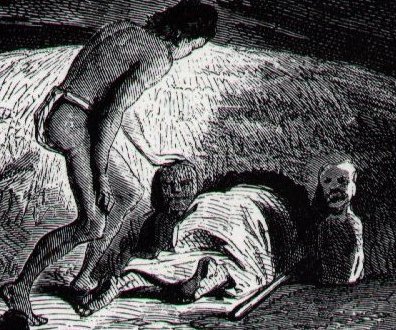2. Maro meaning 'dry' suggests the opposite of the season of 'water'. The season of 'land' (henua) lies in front. The 14th son of Tu was Maroro: ... the progeny of Tu increased: Rongo, Tane, Tangaroa, Rongomai, Kahukura, Tiki, Uru, Ngangana, Io, Iorangi, Waiorangi, Tahu, Moko, Maroro, Wakehau, Tiki, Toi, Rauru, Whatonga - these were the sons ... (Moriori myth of creation accoding to Legends of the South Seas.)
With Rongo, the 1st son mentioned, presumably located at winter solstice and at the beginning of the year, and with Uru as number 7 perhaps at the end of high summer, we can guess the 14th son Maroro should arrive at the threshold to the next new year. ... The expression he uru ki roto ki means to enter into, as for instance he uru ki roto ki te hare. Thus he ea te honu he uru ki roto ki te vai he oho should mean something like 'the turtle got up and entered into the sweet water and was gone' ... Manu uru is an image, not a real 'bird'. At the entrance to a hare paega a pair of such 'beasts' could be stationed, possibly representing the 2 sides of the versatile Mercury, I guess, alternatively Mars and Jupiter:
(Part of a drawing 1872 by Pierre Loti, according to Thor Heyerdahl, Påskön, en gåta som fått svar.) Beyond the 7th son Uru should come the clouds of rain. In my imagination the double eyes in 8 are waterfilled pools (as if Sun was crying):
But he will not 'die' until later. My colours are helpful:
My imagination continues: The 'god of fishes', Tagaroa, is at Venus, after the 'god of forests' has buckled under the weight of the sky roof and darkness once again has covered the earth. A new fire should then ignited with Rongomai, and Sun will appear as the 5th son of Tu. The pattern is beginning with Rongo as Mercury ('Wednesday', the day of turning around). Later Sun should disappear inside his 'hare paega' and the rainy season should arrive. There are 7 periods of 'land' before this happens. But the first 4 of them are without Sun present, 4 + 3 = 7. With Uru like the border line mark of a 'hanging maro' (the end of 'land') there ought to be a 'rising maro' (beginning of land) at the next Mars, viz. Maroro, I think. Between Uru and Maroro there should be 'water' and indeed the 11th son was named Wai-o-rangi ('sky water'). 14 * 28 = 392 is the number of glyphs on side a of the C tablet, which may be just a coincidence but it anyhow makes me guess:
|

